motorrace
Historical figure
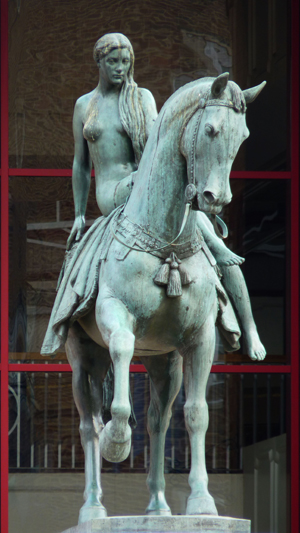
Lady Godiva was the wife of Leofric, Earl of Mercia. They had one proved son Aelfgar, Earl of Mercia.
Lady Godiva's name occurs in charters and the Domesday survey, though the spelling varies. The Old English name Godgifu or Godgyfu meant "gift of God"; Godiva was the Latinised version. Since the name was a popular one, there are contemporaries of the same name.
If she were the same Godiva who appears in the history of Ely Abbey, the Liber Eliensis, written at the end of the 12th century, then she was a widow when Leofric married her. Both Leofric and Godiva were generous benefactors to religious houses. In 1043 Leofric founded and endowed a Benedictine monastery at Coventry on the site of a nunnery destroyed by the Danes in 1016. Writing in the 12th century, Roger of Wendover credits Godiva as the persuasive force behind this act. In the 1050s, her name is coupled with that of her husband on a grant of land to the monastery of St Mary, Worcester and the endowment of the minster at Stow St Mary, Lincolnshire. She and her husband are commemorated as benefactors of other monasteries at Leominster, Chester, Much Wenlock and Evesham. She gave Coventry a number of works in precious metal made for the purpose by the famous goldsmith Mannig, and bequeathed a necklace valued at 100 marks of silver. Another necklace went to Evesham, to be hung around the figure of the Virgin accompanying the life-size gold and silver rood she and her husband gave, and St Paul's Cathedral, London received a gold-fringed chasuble. She and her husband were among the most munificent of the several large Anglo-Saxon donors of the last decades before the Conquest; the early Norman bishops made short work of their gifts, carrying them off to Normandy or melting them down for bullion.
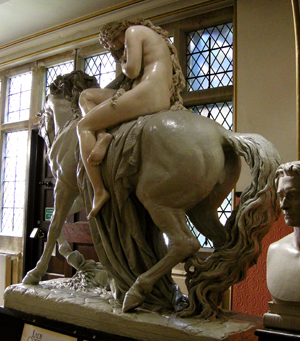
The manor of Woolhope in Herefordshire, along with four others, was given to the cathedral at Hereford before the Norman Conquest by the benefactresses Wulviva and Godiva – usually held to be this Godiva and her sister. The church there has a 20th-century stained glass window representing them.
Her mark, di Ego Godiva Comitissa diu istud desideravi [I, The Countess Godiva, have desired this for a long time], appears on a charter purportedly given by Thorold of Bucknall to the Benedictine monastery of Spalding. However, this charter is considered spurious by many historians. Even so it is possible that Thorold, who appears in the Domesday Book as sheriff of Lincolnshire, was her brother.
After Leofric's death in 1057, his widow lived on until sometime between the Norman Conquest of 1066 and 1086. She is mentioned in the Domesday survey as one of the few Anglo-Saxons and the only woman to remain a major landholder shortly after the conquest. By the time of this great survey in 1086, Godiva had died, but her former lands are listed, although now held by others. Thus, Godiva apparently died between 1066 and 1086.
The place where Godiva was buried has been a matter of debate. According to the Chronicon Abbatiae de Evesham, or Evesham Chronicle, she was buried at the Church of the Blessed Trinity at Evesham, which is no longer standing. According to the account in the Oxford Dictionary of National Biography, "There is no reason to doubt that she was buried with her husband at Coventry, despite the assertion of the Evesham chronicle that she lay in Holy Trinity, Evesham."
Dugdale (1656) says that a window with representations of Leofric and Godiva was placed in Trinity Church, Coventry, about the time of Richard II.
Legend
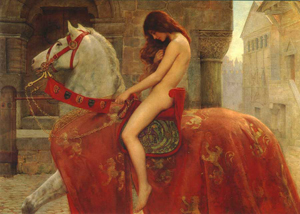
The legend of the nude ride is first recorded in the 13th century, in the Flores Historiarum and the adaptation of it by Roger of Wendover; despite its considerable age, it is not regarded as plausible by modern historians, nor mentioned in the two centuries intervening between Godiva's death and its first appearance, while her generous donations to the church receive various mentions. According to the typical version of the story, Lady Godiva took pity on the people of Coventry, who were suffering grievously under her husband's oppressive taxation. Lady Godiva appealed again and again to her husband, who obstinately refused to remit the tolls. At last, weary of her entreaties, he said he would grant her request if she would strip naked and ride through the streets of the town. Lady Godiva took him at his word and, after issuing a proclamation that all persons should stay indoors and shut their windows, she rode through the town, clothed only in her long hair. Just one person in the town, a tailor ever afterwards known as Peeping Tom, disobeyed her proclamation in one of the most famous instances of voyeurism. In the story, Tom bores a hole in his shutters so that he might see Godiva pass, and is struck blind. In the end, Godiva's husband keeps his word and abolishes the onerous taxes.
Some historians have discerned elements of pagan fertility rituals in the Godiva story whereby a young "May Queen" was led to the sacred Cofa's tree perhaps to celebrate the renewal of spring The oldest form of the legend has Godiva passing through Coventry market from one end to the other while the people were assembled, attended only by two knights. This version is given in Flores Historiarum by Roger of Wendover (died 1236), a somewhat gullible collector of anecdotes, who quoted from unnamed earlier writers.
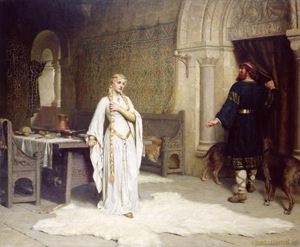
Other attempts to find a more plausible rationale for the legend include one based on the custom at the time for penitents to make a public procession in their shift, a sleeveless white garment similar to a slip today and one which was certainly considered "underwear". Thus Godiva might have actually travelled through town as a penitent, in her shift. Godiva's story could have passed into folk history to be recorded in a romanticised version. Another theory has it that Lady Godiva's "nakedness" might refer to her riding through the streets stripped of her jewellery, the trademark of her upper class rank. However, both of these attempts to reconcile known facts with legend are weak; in the era of the earliest accounts, the word "naked" is only known to mean "without any clothing whatsoever".
A modified version of the story was given by printer Richard Grafton, later elected MP for Coventry. According to his Chronicle of England (1569), "Leofricus" had already exempted the people of Coventry from "any maner of Tolle, Except onely of Horsse (sic.)"[citation needed], so that Godiva ("Godina" in text) had agreed to the naked ride just to win relief for this horse tax. And as a pre-condition, she required the officials of Coventry to forbid the populace "upon a great pain" from watching her, and to shut themselves in and shutter all windows on the day of her ride. Grafton was an ardent Protestant and sanitized the earlier story.
The ballad "Leoffricus" in the Percy Folio (ca. 1650) conforms to Grafton's version, saying that Lady "Godiua" performed her ride to remove the customs paid on horses, and that the town's officers ordered the townsfolk to "shutt their dore, & clap their windowes downe," and remain indoors on the day of her ride.
Peeping Tom
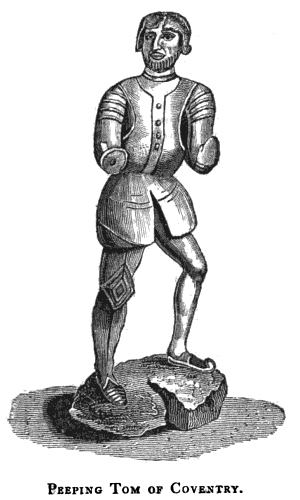
The later embellished episode of "Peeping Tom", who alone among the townsfolk peeked at the Lady Godiva riding naked, probably did not originate in literature, but came up through popular lore in the locality of Coventry. Reference by 17th-century chroniclers has been claimed, but in the following all published accounts are 18th-century or later.
According to an 1826 article submitted by a person well-versed in local history identifying himself as W. Reader, there was already a well-established tradition before his time that there was a certain tailor who had taken a peek at Lady Godiva, and that at the annual Trinity Great Fair (now called the Godiva Festival) featuring the Godiva processions "a grotesque figure called Peeping Tom" would be set on display, and it was a wooden statue carved from oak. The author has dated this effigy, based on the style of armour he is shown wearing, from the reign of Charles II (d. 1685). The same writer felt the peeper legend had to postdate William Dugdale (d. 1686) since antiquary made no mention in his huge tomes that discussed Coventry in extenso. (It should be noted that the lore about the tailor as peeper and the use of wooden effigy may be as old as the 17th century, but the effigy may not have always been called "Tom". See 1773 date below, and the alternate suggested name "Action".)
W. Reader dates the first Godiva procession to 1677, but other sources date the first parade to 1678, and on that year a lad from the household of James Swinnerton enacted the role of Lady Godiva.
Regarding the track record of Godiva's peeper as recorded in published writings, the English Dictionary of National Biography gives a meticulous account. The historian Paul de Rapin (1732) reported the Coventry lore that Lady Godiva performed her ride while "commanding all Persons to keep within Doors and from their Windows, on pain of Death" but one man could not refrain from looking and it "cost him his life"; Rapin further reported that the town commemorates this with a "Statue of a Man looking out of a Window."
Next, Thomas Pennant in Journey from Chester to London (1782) recounted how "the curiousity of a certain taylor overcoming his fear, he took a single peep".[citation needed] Pennant noted that the person enacting Godiva in the procession was not fully naked of course, but wore "silk, closely fitted to her limbs", which had a color resembling the skin's complexion. (In Chester's time around 1782 silk was worn, but the annotator of the 1811 edition noted that a cotton garment had since replaced the silk fabric.) According to the Dict. Nat. Biog., the oldest document that mentions "Peeping Tom" by name is a record in Coventry's official annals, dating to June 11, 1773, documenting that the city issued a new wig and paint for the wooden effigy. There is further description given on the Godiva procession under the sub-article Lady Godiva in popular culture.
There is also said to be a letter from pre-1700, stating that peeper was actually Action (pronounced Actæon?), Lady Godiva's groom.
Additional legend proclaims that Peeping Tom was later struck blind as heavenly punishment, or that the townspeople took the matter in their own hands and blinded him.
The Peeping Tom story is absent from the few sources contemporary with Godiva. It has been pointed out that Tom (Thomas) is not an Anglo-Saxon name, and therefore hardly likely to be a name of a townsperson governed by Leoffric. Coventry was still a small settlement, with only 69 families (and the monastery) recorded in the Domesday Book some decades later. Lastly, the only recorded tolls were on horses. Thus, it remains doubtful whether there is any historical basis for the famous ride. The story is particularly doubtful since Countess Godiva would herself have been responsible for setting taxation in Coventry; Salic law, which excluded females from the inheritance of a throne or fief, did not apply in Anglo-Saxon society. If only because of the nudity in the story, its popularity has been maintained, and spread internationally, with many references in modern popular culture.
Images in art and society
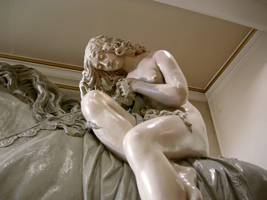
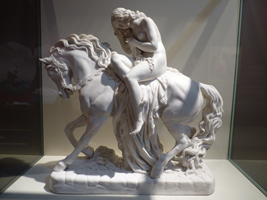
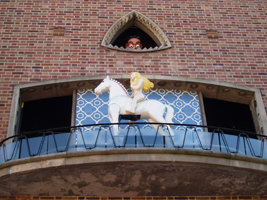
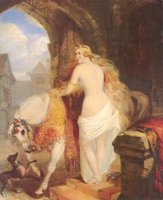
The Herbert Art Gallery & Museum, in Coventry, maintains a permanent exhibition on the subject. The oldest painting was commissioned by the County of the City of Coventry in 1586 and produced by Adam van Noort, a refugee Flemish artist. His painting depicts a "voluptuously displayed" Lady Godiva against the background of a "fantastical Italianate Coventry". In addition the Gallery has collected many Victorian interpretations of the subject described by Marina Warner as "an oddly composed Landseer, a swooning Watts and a sumptuous Alfred Woolmer".
Colliers' Lady Godiva (above) was bequeathed by social reformer, Thomas Hancock Nunn. When he died in 1937, the painting was offered to the Corporation of Hampstead. He specified in his will that should his bequest be refused by Hampstead (presumably on grounds of propriety) the painting was then to be offered to Coventry. The painting now hangs in the Herbert Art Gallery and Museum.
Popular Songs
The British musical group Peter and Gordon had a number six hit in 1966, to wit: "Seventeen a beauty queen She made a ride that caused a scene In the town
Her long blonde hair Hangin' down around her knees All the cats who dig striptease Prayin' for a little breeze Her long blonde hair Falling down across her arms Hiding all the lady's charms Lady Godiva
She found fame and made her name A hollywood director came into town And said to her "How'd you like to be a star?" "You're a girl that could go far" "'specially dressed the way you are" She smiled at him Gave her pretty head a shake That was Lady G's mistake A-hey-hey-hey Lady Godiva
He directs certificate 'X' And people now are craning their necks To see her 'Cause she's a star One that everybody knows Finished with the striptease shows Now she can't afford her clothes
Her long blonde hair Lyin' on the barber's floor Doesn't need it long anymore Lady Godiva"